
The champagne view across the Australian Alps. Falls Creek
When people mention Kosciusko, Thredbo, Perisher, Falls Creek and Mount Hotham, you expect them to be talking about skiing. But there’s more to these locations than powder snow and moguls.
Spring is an ideal time to see Australia’s alps. The thaw has left plenty of wide tracks, crystal clear streams and a nip in the air.
And there are many ways to explore the high country – from taking Shank’s pony, sitting astride a mighty colt from Old Regret or thereabouts, keeping your cadence up while imaging yourself on the Mont Blanc passes of the Tour de France, or even being carried along by a newfangled invention – the Segway.
Falls Creek on two wheels
When you talk about travelling on two wheels, you usually expect them to be one in front of the other. But the latest craze to hit tourist spots around the world is the Segway. These motorised two-wheeled vehicles are easy to learn to drive, and are as much fun as they look.
You can test out whether you like them or not by taking a Segway Teaser trial ($15) along the grassy slope of Slalom Plaza at Falls Creek. If it takes your fancy, go for a full hour ($60) where you can explore the resort, lake and aqueduct.
Another way to navigate the area is by canoe along Rocky Valley Lake – Australia’s highest lake. Two hour sessions are $30 (children half-price) and include a twoperson canoe, paddles, lifejackets and first-aid trained supervision on shore (with a rescue boat handy – just in case). Fishing gear can be hired from the Visitor Information Centre.
The most popular way to get around Falls Creek in the sunnier months is by traditional bicycle – whether hitting the road or hitting the trails, there is plenty to explore and enjoy in the Alpine National Park.
There are both road bike and mountain bike options. Adult bike hire starts at $40 for a half day, to $55 for a full day.
Whether you enjoy cruising with the family, powering up hills or blazing down them, there’s a wide selection of tracks to suit all levels of skill and fitness. Rides range from the easy shared trails along the village aqueducts to more challenging trails that take in Pretty Valley, Howmans Gap and Mount Beauty.
The Summit Chairlift is in operation on selected dates, allowing for greater access to ride some of Falls Creek’s best cross-country trails.
Some of these trails include the following: Historic Huts Ride (11.4km) – an easy ride along the Aqueducts to Wallace’s and Cope Huts. Suitable for the whole family. Mt McKay Loop (13.6km) – climb your way to the top of the resort and be rewarded with majestic views of the Bogong High Plains. Tougher ride. Tawonga Huts Run (25km) – day-long ride out to Tawonga Huts. A big haul up Mt McKay Road, then it’s fairly technical once you cross Pretty Valley Dam. Usually see brumbies and the views are worth it. Marum Point Paralyser (17.4km) – a great free flowing trail from Watchbed Creek. If you’re a mad hill-climber, then take the Mt Nelse variant – the reward is a wild run home.
Falls Creek Resort Management has received funding to develop downhill mountain-bike tracks and will be working hard over the next four years to produce what will hopefully be amongst some of the most challenging and intensive around.

Look Ma, I’m on top of the world! A bushwalker has made it up to the glacial Lake Albina in the Kosciusko National Park. Tourism NSW
Mount Buller is also excellent for road cycling, and you can test your stamina by cycling up to the Resort on the Mt Buller Tourist Road – a 16 kilometre uphill grind that stretches from the base of the mountain to the top. This climb rises 909 vertical metres with an average grade of six per cent and a number of sections that reach 12 per cent.
The cycling challenge allows you to take in some spectacular High Country scenery while pushing your body to the limit. Regular signposts on the roadside allow you to chart your progress up the mountain, advising you of the altitude you have reached and the number of kilometres to go until you get to the Mt Buller Village.
Elite athletes train on the Mt Buller Road, including champion cyclist Simon Gerrans, who completed the climb in an impressive 39 minutes and 50 seconds. We don’t expect many readers of The Wanderer to match his time – but you never know.
When built, another Mt Buller ride will be the Epic Mountain Bike Trail – a 40 kilometre trail that offers visitors a long distance, cross-country descending ride, providing stunning views across the Victorian High Country.
Trekking through history
You can take a hike through history along the Packhorse Heritage Trail. This is the newest addition to Falls Creek’s worldclass network of high country walking tracks. The newly developed trail takes hikers from Falls Creek Village to the Howmans Gap Alpine Centre along the old packhorse trail that early cattlemen and surveyors used to access the Bogong High Plains.

Getting off-road on mountains bikes is an adrenalin pumping alternative. Mt Buller
The track has long been recalled by Falls Creek old timers but it has only been since the 2003 bushfires that it has become exposed again. It is now a Falls Creek icon, offering first-hand insights into the devastation caused by the fires and the incredible regeneration seen since.

Tasmania’s Ben Lomand also has picturesque trail bike routes. Tourism Tasmania
It is 8.4 kilometres return and is suitable for intermediate level walkers. There is a one-way pickup point at Howmans Gap.
One really good long trek is from Mt Hotham to Falls Creek – a 25 kilometres epic across the spectacular High Plains. This self-guided tour includes passing spectacular features such as the Razorback Ridge, Mt Feathertop and the basalt column structures that gave Ruined Castle its name. The Tawonga and other historic huts and mines along the way give a glimpse into the history of the High Country and any number of wildlife can be encountered – from pygmy possums to wild brumbies and emus.
This self-guided walk is offered for $45 with trip notes and transportation to Hotham. Shuttles run every Thursday and Saturday throughout January. Group bookings can be arranged on any day with 24 hours’ notice.
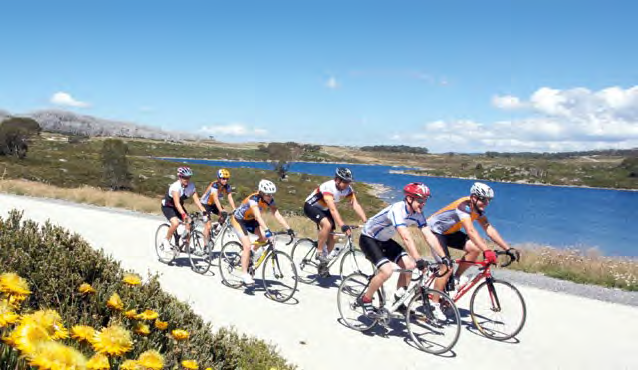
Road cycling and racing is popular in the Alps. Falls Creek
High Country Huts
Take a step back in time with the historic Cattlemen’s Huts of the Bogong High Plains.
The High Country huts are historic monuments nestled in the spectacular Alpine National Park. Some huts date back to the 1860s and remain a testament to the pioneers who lived, explored and worked on this land. While a few huts were used as homes for workers, others were built to shelter skiers and hikers. Each hut has its own story. Pack a lunch and take a tour of the high country huts. You can also get guided tours.
Wallace’s Hut was built in 1889 by the Wallace brothers (Arthur, William and Stewart). This Hut is one of the oldest mountain huts in the Alpine National Park. Made from snow gum and woollybutt, the roof was replaced when used as a worker’s hut around 1946. Drive out past Windy Corner and across the Rocky Valley dam wall for approximately 12 kilometres until you see the marked signs to the Hut. Park your car and from here it is an easy and very picturesque 750 metre walk into the Hut.
Cope Hut was proposed by the Ski Club of Victoria as a ski refuge and funded by the State Tourist Committee in 1929. The structure is made from adzed softwood and polished hardwood with a corrugated iron roof. Materials came by dray to Dibbins, then by sled to the High Plains. The Hut was classified by the National Trust in 1988. Access to Cope Hut is via the Bogong High Plains Road. Pass the Wallace Hut car park and stop at the next side track on the left. Walk about 250 metres from the roadside gate.
Many huts have sat on the site of the Tawonga Huts, with the first built by cattleman John Ryder. This hut was pulled down in 1888 by a horse that was tethered to the hut, but was replaced that same year. A second hut was built in 1923. Currently four huts exist on a site 250 metres south of the original site, set amongst snowgums next to a small creek. The oldest surviving hut was built in 1928 and towed from Pretty Valley by bulldozer in the 1980s. The huts as a group are recognised as significant by the National Trust. The walk follows a fire trail from Pretty Valley Dam and is eight kilometres return from the carpark.
Johnston’s Hut was built by Chris and William Johnston in the early 1930s. As the only hut in the alpine area for sheep grazing, it soon became popular as a refuge for skiers. In 1966 the Ski Club of East Gippsland acquired the permissive occupancy. The Hut burnt down on 17 May 1976 and was replaced with an almost identical hut not long after. A section, of the hut is unlocked as a refuge. The main section which has lighting and heating can be booked by the public by contacting the Ski Club of East Gippsland.

Wallace’s Hut, built in 1889, is one of the many historic huts in the Alps. Falls Creek
Other huts include Edmonson’s Hut built in 1953, Pretty Valley Hut built in the early 1930s and Fitzgerald’s Hut built in 1903.
Kosciusko
Kosciusko National Park is New South Wales’s largest national park. Few visitors can resist standing on Australia’s highest point – the 2,228 metre Mt Kosciusko. Other attractions include impressive scenery, wildflowers in late spring, horse riding, bushwalking and mountain biking.
There are plenty of things to do in the spring, summer and autumn in Kosciusko, such as taking an airborne tour on the Kosciuszko Express Chairlift, a twokilometre ride up 560 vertical metres from Thredbo, with spectacular views across the valley.
Jindabyne is an excellent base for outdoor activities, including fishing, sailing and water sports on Lake Jindabyne. Tumbarumba is also excellent for fishing and walking, vineyards, heritage exploration and a peaceful atmosphere. Lake Eucumbene provides one of the best fisheries in the mountains, just the place to bag a rainbow trout, brown trout or fine Atlantic salmon.
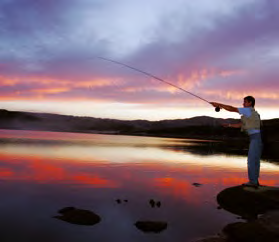
Alpine fishing is some of the best – especially if you like fresh trout or even salmon. Falls Creek
For those who want to venture underground, the Yarrangobilly Caves have stunning limestone formations and natural thermal pools.
There is plenty of scope for great bushwalking, including the Main Range Track from Charlotte Pass, considered one of the country’s best day walks, following the Snowy River to the summit of Mt Kosciuszko.
The Australian Alps Walking Track is a 665 kilometre route providing remote and rugged High Country scenery. Naturally, it is best tackled in short sections.
There are also huts on this side of the border. You can explore Nimmitabel on a one-hour heritage walk that takes in heritage buildings from the 1860s. At Delegate, the 1840s Early Settlers Hut provides a wonderful insight into the lives of early European squatters. And in Tumbarumba, the Pioneer Women’s Hut is an unusual museum themed on women’s challenges in early rural Australia.
You can also stay at the Moonbah Hut – a quaint, secluded and romantic hut, beautifully designed to offer a romantic getaway or a fishing lover’s dream on the banks of the Moonbah River.
One of the biggest tourist drawcards is the amazing history and science of the Hydro-Electric Scheme. In Cooma, the pages of schoolbooks come alive at the state-of-the-art Snowy Hydro Discovery Centre, which tells the story of the construction and important role of the Snowy Mountains Hydro-Electric Scheme. You can also view the power stations at Talbingo and Murray near Khancoban.

Canoeing on Rocky Valley Lake, Australia’s highest lake. Falls Creek
There are also a number of events in Kosciusko during spring:
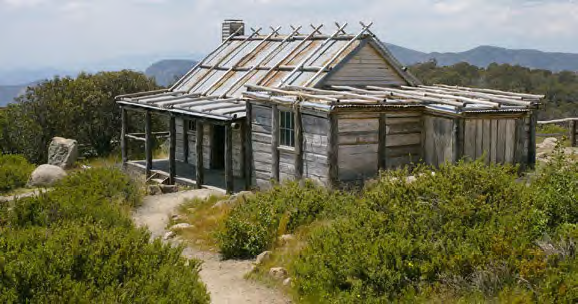
You can follow a series of tracks to find many historic huts – and even stay in some of them. Mt Buller
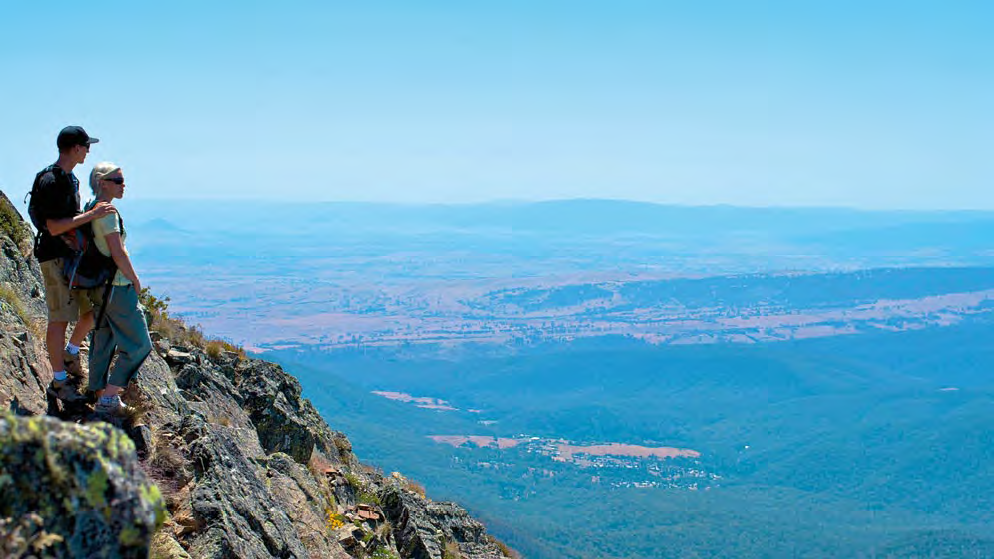
The view is worth the hike. Mt Buller
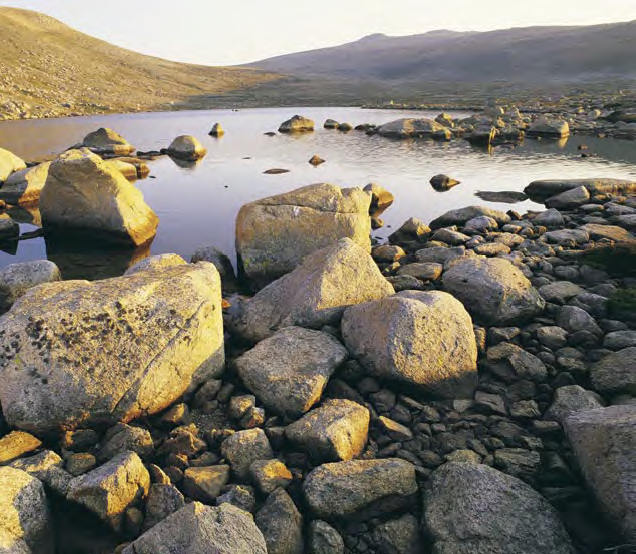
Moraine at the top of Kosciusko. Tourism NSW

The chairlift can help you get to the top of the mountain bike trials. Tourism NSW
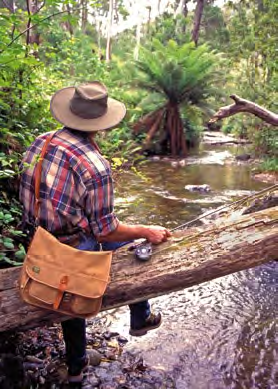
Perfect serenity in a tranquil fishing spot. Mt Buller
Ben Lomond
Ben Lomond National Park is a large plateau atop precipitous cliffs that dominate the plains of rural northeastern Tasmania.
The park covers an area of 16,527 hectares including the island’s secondhighest peak, Legges Tor, which is 1,572 metres (5,147 feet) above sea level. Just 50 kilometres from Launceston, Ben Lomond is Tasmania’s principal downhill ski field – but it is also a spectacular attraction in the warmer months.
Tasmania’s characteristic dolerite columns so prized by rock-climbers and abseilers are especially dramatic here. Wildflowers abound in summer, and although much of the plateau is stony, elsewhere on the mountain there are dense forests and moorlands.
The hairpin bends of the road known as Jacobs Ladder and the sweeping views from its lookout make the drive to the plateau an experience in itself. If you are planning to bushwalk be sure to have windproof and rainproof gear – the weather can change rapidly, whatever the season. And be aware that no petrol is available on the mountain.
Please note, prices subject to change, and may vary to that listed in this article.
Category: Features
Written: Sun 01 Sept 2013
Printed: September, 2013
Published By:
For more information:
Tourism Victoria: www.visitvictoria.com or 13 28 42
Falls Creek: www.fallscreek.com.au
Mt Buller: www.mtbuller.com.au
Mt Hotham: www.mthotham.com.au
Travel NSW: www.visitnsw.com.au or 13 20 77
Moonba Hut: www.moonbahhut.com
Snowy River Hydro Electric Scheme: www.snowyhydro.com.au
Tourism Tasmania: www.discovertasmania.com or 1300 733 258